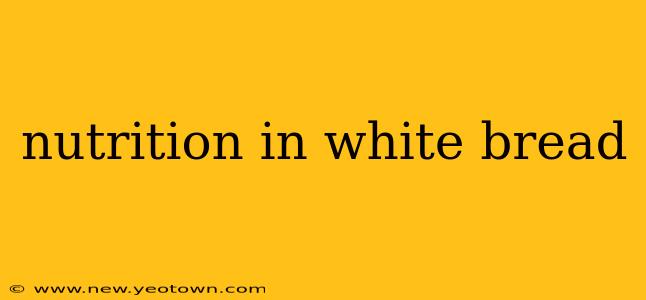White bread. It's a staple in many pantries, a quick and easy addition to sandwiches, toast, and croutons. But beyond its convenience, what's the nutritional story behind this ubiquitous loaf? Many dismiss white bread as nutritionally void, but the reality is a bit more nuanced. Let's dive into the often-overlooked nutritional aspects of white bread and explore some frequently asked questions.
What are the main nutrients in white bread?
White bread, despite its processed nature, does offer some nutritional value. Think of it less as a nutritional powerhouse and more as a contributor to your overall daily intake. A typical slice will provide small amounts of carbohydrates, primarily in the form of starch, which the body uses for energy. It also contains small amounts of protein and some B vitamins, particularly thiamine (B1), riboflavin (B2), and niacin (B3). These are often added during the enrichment process. Furthermore, you'll find trace minerals like iron and folate, although the bioavailability (how well your body absorbs them) can vary. However, it's important to remember that these nutrients are present in relatively small quantities compared to whole-grain alternatives.
Is white bread healthy?
This is a question with no simple yes or no answer. The healthfulness of white bread depends largely on context and moderation. In moderation, as part of a balanced diet, it’s unlikely to cause harm. However, relying on white bread as a primary carbohydrate source can be problematic. It lacks the fiber found in whole-grain breads, which is crucial for digestive health and regulating blood sugar levels. The refined nature of white bread also means it's lower in essential vitamins and minerals compared to whole-grain options. The high glycemic index (GI) of white bread means it can lead to rapid spikes in blood sugar, potentially contributing to long-term health issues if consumed excessively.
How many calories are in a slice of white bread?
The calorie count of a slice of white bread can vary depending on the brand and the size of the slice. However, a typical slice will contain around 70-80 calories. These calories primarily come from carbohydrates. It's crucial to be mindful of portion sizes, as even seemingly small caloric contributions can add up throughout the day.
What are the benefits of white bread?
While not a nutritional superstar, white bread does have a few advantages. Its soft texture makes it easier to chew and digest than many other breads, which can be beneficial for people with certain dental or digestive issues. Furthermore, its affordability and availability make it an accessible option for many individuals. Its neutral flavor profile also allows for greater versatility in culinary applications.
Is white bread good for weight loss?
White bread is not typically recommended for weight loss due to its low fiber content and relatively high glycemic index. The lack of fiber means it doesn't promote satiety (feeling full), making it easier to overeat. The rapid rise in blood sugar can also lead to energy crashes and increased cravings, potentially hindering weight loss efforts. Whole-grain options are generally preferred for weight management due to their higher fiber content and lower glycemic index.
What are the alternatives to white bread?
The best alternatives to white bread are whole-grain breads. These breads are made from whole grains, retaining the bran, germ, and endosperm, which provide a wealth of fiber, vitamins, and minerals. Look for breads with high fiber content, a lower glycemic index, and minimal added sugars. Other alternatives include sourdough bread, rye bread, and various gluten-free options.
Conclusion: A Balanced Perspective
White bread, in moderation and as part of a balanced diet, isn't necessarily harmful. However, its nutritional value pales in comparison to whole-grain alternatives. Understanding its limitations and making informed choices allows for a more balanced approach to nutrition. Choosing whole grains whenever possible offers a significantly more nutritious and beneficial option for long-term health. Prioritize a varied diet rich in fruits, vegetables, and whole grains to ensure you're meeting your daily nutritional needs.

